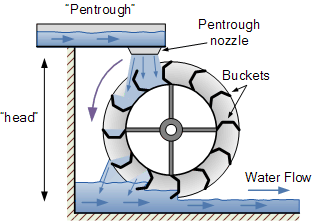


Glenn Herbert wrote:B Beeson's post in the thread I linked to gives the power formula.
For you, 1500gpm x 8ft / 5.6 = 2142w. Apply efficiency & conversion factors, say 80% for a pitchback wheel, 50% for gearing up to generator speed. Flume losses as B mentioned are irrelevant, as that happens before you start the power calculation. This gives you something like 856 watts continuous output 24/7, which you would want to store in batteries for use as needed. I'm not an electrician or electrical engineer, but that sounds pretty good.

Eric Hanson wrote:Aaron,
For the purposes of turning a generator, you might wish to increase the water velocity. I don't know if this is possible in your setup, but I have heard of people making a little dam and then piping water downhill to the actual genset. The purpose is to really get the pressure up high to get the water flowing fast enough to turn the genset a meaningful RPM. At the end of the pipe, instead of being attached to a water wheel, the pipe is attached to a water turbine which then connects to the genset.
Again, I don't know if this is possible in you situation as it requires a fairly large drop in height, but it is one option.
Good luck,
Eric

Glenn Herbert wrote:This recent thread Waterwheel. Power expectations? has good information and a link to a weir calculator: WSU contracted rectangular weir calculator.

Glenn Herbert wrote:As you mention an 8' pitchback wheel, I assume you have 8' of head available.
Glenn Herbert wrote:You mention flowing 3mph over the weir, which seems very slow. Do you have a weir that drops the water immediately after it, or is this just a cross section of a flowing channel?
